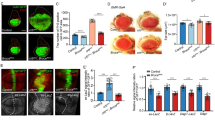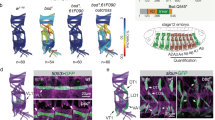Abstract
Although mutations that activate the Hedgehog (Hh) signalling pathway have been linked to several types of cancer1, the molecular and cellular basis of Hh's ability to induce tumour formation is not well understood. We identified a mutation in patched (ptc), an inhibitor of Hh signalling, in a genetic screen for regulators of the Retinoblastoma (Rb) pathway in Drosophila. Here we show that Hh signalling promotes transcription of Cyclin E and Cyclin D, two inhibitors of Rb2, and principal regulators of the cell cycle during development in Drosophila. Upregulation of Cyclin E expression, accomplished through binding of Cubitus interruptus (Ci) to the Cyclin E promoter, mediates the ability of Hh to induce DNA replication. Upregulation of Cyclin D expression by Hh mediates the distinct ability of Hh to promote cellular growth. The discovery of a direct connection between Hh signalling and principal cell-cycle regulators provides insight into the mechanism by which deregulated Hh signalling promotes tumour formation.
This is a preview of subscription content, access via your institution
Access options
Subscribe to this journal
Receive 51 print issues and online access
$199.00 per year
only $3.90 per issue
Buy this article
- Purchase on Springer Link
- Instant access to full article PDF
Prices may be subject to local taxes which are calculated during checkout





Similar content being viewed by others
References
Ruiz i Altaba, A. Gli proteins and Hedgehog signaling: development and cancer. Trends Genet. 15, 418–425 (1999)
Weinberg, R. A. The retinoblastoma protein and cell cycle control. Cell 81, 323–330 (1995)
Wolff, T. & Ready, D. F. in The Development of Drosophila melanogaster (ed. Bate, M.Arias, A. M.) 1277–1326 (Cold Spring Harbor Laboratory Press, Plainview, New York, 1993)
Dyson, N. The regulation of E2F by pRB-family proteins. Genes Dev. 12, 2245–2262 (1998)
Xin, S., Weng, L., Xu, J. & Du, W. The role of RBF in developmentally regulated cell proliferation in the eye disc and in Cyclin D/Cdk4 induced cellular growth. Development 129, 1345–1356 (2002)
McMahon, A. P. More surprises in the Hedgehog signaling pathway. Cell 100, 185–188 (2000)
Huang, Z. & Kunes, S. Signals transmitted along retinal axons in Drosophila: Hedgehog signal reception and the cell circuitry of lamina cartridge assembly. Development 125, 3753–3764 (1998)
Finley, R. L. Jr, Thomas, B. J., Zipursky, S. L. & Brent, R. Isolation of Drosophila cyclin D, a protein expressed in the morphogenetic furrow before entry into S phase. Proc. Natl Acad. Sci. USA 93, 3011–3015 (1996)
Knoblich, J. A. et al. Cyclin E controls S phase progression and its down-regulation during Drosophila embryogenesis is required for the arrest of cell proliferation. Cell 77, 107–120 (1994)
Ewen, M. E. Where the cell cycle and histones meet. Genes Dev. 14, 2265–2270 (2000)
Lane, M. E. et al. Dacapo, a cyclin-dependent kinase inhibitor, stops cell proliferation during Drosophila development. Cell 87, 1225–1235 (1996)
de Nooij, J. C., Letendre, M. A. & Hariharan, I. K. A cyclin-dependent kinase inhibitor, Dacapo, is necessary for timely exit from the cell cycle during Drosophila embryogenesis. Cell 87, 1237–1247 (1996)
Jones, L., Richardson, H. & Saint, R. Tissue-specific regulation of cyclin E transcription during Drosophila melanogaster embryogenesis. Development 127, 4619–4630 (2000)
Zarkower, D. & Hodgkin, J. Zinc fingers in sex determination: only one of the two C. elegans Tra-1 proteins binds DNA in vitro. Nucleic Acids Res. 21, 3691–3698 (1993)
Secombe, J., Pispa, J., Saint, R. & Richardson, H. Analysis of a Drosophila cyclin E hypomorphic mutation suggests a novel role for cyclin E in cell proliferation control during eye imaginal disc development. Genetics 149, 1867–1882 (1998)
Stocker, H. & Hafen, E. Genetic control of cell size. Curr. Opin. Genet. Dev. 10, 529–535 (2000)
Neufeld, T. P., de la Cruz, A. F., Johnston, L. A. & Edgar, B. A. Coordination of growth and cell division in the Drosophila wing. Cell 93, 1183–1193 (1998)
Datar, S. A., Jacobs, H. W., de La Cruz, A. F., Lehner, C. F. & Edgar, B. A. The Drosophila cyclin D–cdk4 complex promotes cellular growth. EMBO J. 19, 4543–4554 (2000)
Meyer, C. A. et al. Drosophila cdk4 is required for normal growth and is dispensable for cell cycle progression. EMBO J. 19, 4533–4542 (2000)
Johnson, R. L., Grenier, J. K. & Scott, M. P. patched overexpression alters wing disc size and pattern: transcriptional and post-transcriptional effects on hedgehog targets. Development 121, 4161–4170 (1995)
Kenney, A. M. & Rowitch, D. H. Sonic hedgehog promotes G(1) cyclin expression and sustained cell cycle progression in mammalian neuronal precursors. Mol. Cell. Biol. 20, 9055–90567 (2000)
Milenkovic, L., Goodrich, L. V., Higgins, K. M. & Scott, M. P. Mouse patched1 controls body size determination and limb patterning. Development 126, 4431–4440 (1999)
Fantl, V., Stamp, G., Andrews, A., Rosewell, I. & Dickson, C. Mice lacking cyclin D1 are small and show defects in eye and mammary gland development. Genes Dev. 9, 2364–2372 (1995)
Donnellan, R. & Chetty, R. Cyclin E in human cancers. FASEB J. 13, 773–780 (1999)
Wang, T. C. et al. Mammary hyperplasia and carcinoma in MMTV–cyclin D1 transgenic mice. Nature 369, 669–671 (1994)
Xu, T. & Rubin, G. M. Analysis of genetic mosaics in developing and adult Drosophila tissues. Development 117, 1223–1237 (1993)
Struhl, G. & Basler, K. Organizing activity of wingless protein in Drosophila. Cell 72, 527–540 (1993)
Patel, N. in In situ Hybridization to Whole Mount Drosophila Embryos (ed. Krieg, P. A.) 357–370 (Wiley-Liss, New York, 1996)
Bosco, G., Du, W. & Orr-Weaver, T. L. DNA replication control through interaction of E2F-RB and the origin recognition complex. Nature Cell Biol. 3, 289–295 (2001)
Johnston, L. A. & Edgar, B. A. Wingless and Notch regulate cell-cycle arrest in the developing Drosophila wing. Nature 394, 82–84 (1998)
Acknowledgements
We thank J. Jiang, B. Edgar, C. Lehner, R. Holmgren, H. Richardson, T. Kornberg and the Bloomington Stock Center for providing fly stocks and antibodies used in this study. We gratefully acknowledge C. Heitzig and M. Giorgianni, who performed preliminary experiments that contributed to this work. C. Gudanowski provided technical assistance. We thank E. Williamson and the University of Chicago scanning electron microscope facility, as well as J. Auger and the University of Chicago Flow Cytometry Facility, for their technical advice. We are grateful for discussions with members of the Du lab, the Patel lab, and the Center for Molecular Oncology. Comments from C. Ferguson, A. Mahowald, N. Dyson and J. Duman aided us in the preparation of this manuscript. We thank B. Edgar for communicating results to us before publication. Grants from the American Cancer Society and the National Institutes of Health to W.D. supported this work.
Author information
Authors and Affiliations
Corresponding author
Ethics declarations
Competing interests
The authors declare that they have no competing financial interests.
Supplementary information
Rights and permissions
About this article
Cite this article
Duman-Scheel, M., Weng, L., Xin, S. et al. Hedgehog regulates cell growth and proliferation by inducing Cyclin D and Cyclin E. Nature 417, 299–304 (2002). https://doi.org/10.1038/417299a
Received:
Accepted:
Issue Date:
DOI: https://doi.org/10.1038/417299a
This article is cited by
-
Hedgehog signalling is involved in acquired resistance to KRASG12C inhibitors in lung cancer cells
Cell Death & Disease (2024)
-
Hedgehog signaling in tissue homeostasis, cancers, and targeted therapies
Signal Transduction and Targeted Therapy (2023)
-
The role of hypoxia on prostate cancer progression and metastasis
Molecular Biology Reports (2023)
-
Heparanase and the hallmarks of cancer
Journal of Translational Medicine (2020)
-
Hedgehog signaling promotes sorafenib resistance in hepatocellular carcinoma patient-derived organoids
Journal of Experimental & Clinical Cancer Research (2020)
Comments
By submitting a comment you agree to abide by our Terms and Community Guidelines. If you find something abusive or that does not comply with our terms or guidelines please flag it as inappropriate.



